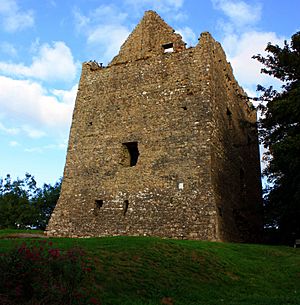Dunmore Castle facts for kids
Quick facts for kids Dunmore Castle |
|
|---|---|
| Native name Irish: Caisleán an Dúin Mhóir |
|
 |
|
| Type | keep (donjon) |
| Location | Castlefarm, Dunmore, County Galway, Ireland |
| Built | 14th–16th century |
| Owner | State |
| Official name: Dunmore Castle | |
| Reference no. | 248 |
| Lua error in Module:Location_map at line 420: attempt to index field 'wikibase' (a nil value). | |
Dunmore Castle is an old castle in County Galway, Ireland. It's also a special place called a National Monument, which means it's protected because of its history. This amazing castle has stood for hundreds of years, telling stories of kings, battles, and changing times.
Contents
Where is Dunmore Castle?
Dunmore Castle is found about 1 kilometer (0.6 miles) northwest of the town of Dunmore, County Galway. It sits right on the north bank of the Sinking River. Imagine a castle next to a river – a perfect spot for defense in olden times!
The Castle's Long History
Local stories say that Dunmore (which means "great hillfort" in Irish) was once a smaller home for the ancient Kings of Connacht. This shows how important the area was even before the stone castle was built.
Building the First Castle
The very first castle at Dunmore was built by the De Birmingham family in the early 1200s. They built it to protect against attacks from the Gaelic Irish people. It was like a strong wall to keep their lands safe.
Battles and Changes
Over the years, Dunmore Castle saw many fights.
- In 1249, the castle was attacked and burned by the Ó Conchubhair family.
- Later, in 1284, it was surrounded and attacked by the Síol Maelruain group.
- In 1315, a man named Rory O'Conor damaged the castle during a big war called the Bruce campaign in Ireland.
Most of the castle you see today was built in the early 1300s. It was first a two-story hall keep, which is a strong central tower. In the 1500s, the castle got some updates. New floors were added, along with roof gables, chimneys, and windows. They even added a new entrance on the ground floor.
Royal Troubles and New Owners
The de Bermingham family, who owned the castle, rebelled against Queen Elizabeth I of England. Because of this, the castle was taken from them in 1569 by Sir Henry Sidney, a powerful leader in Ireland. However, the de Berminghams got it back later.
But their ownership didn't last forever. The castle was taken from them for good in the 1650s, during a time known as the Cromwellian conquest in Ireland. After that, the Ouseley family lived in the castle until the 1800s. A famous preacher named Gideon Ouseley was part of this family.
In the 1800s, a lime kiln (a type of oven for making lime) was built on the castle site. Today, Dunmore Castle is looked after by the Office of Public Works. They make sure this important piece of history is protected for everyone to see.
What Does the Castle Look Like?
Dunmore Castle is a rectangular keep, which means it's a tall, strong tower. It has five stories and measures about 14 by 8.2 meters (46 by 27 feet) at its base. The bottom of the castle has a wide, sloping base called a base-batter, which made it harder to attack.
You can still see signs of a garderobe (an old toilet) on the northwest side. The windows are interesting too, with different shapes like an oculus (a round window), mullions (vertical bars dividing a window), and arrowslits (narrow openings for archers to shoot through). Some parts of the original curtain wall, which was the outer wall protecting the castle, are still standing.


